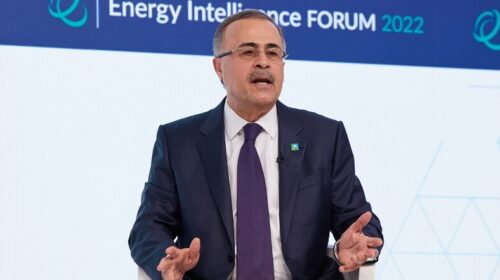Saudi Aramco CEO Amin Nasser has sent a stark warning about the lack of spare oil production capacity, telling the Energy Intelligence Forum that an uptick in demand could cause a supply crunch and price volatility similar to that seen in the gas market.
With benchmark crude prices falling by around $30 per barrel since June, Nasser said the market was focusing on short-term economics rather than supply fundamentals.
But with only around 1.5 million barrels per day of global spare capacity, Nasser argued that if Chinese demand picks up, or the aviation industry bounces back, that slim buffer could be eroded fast.
Global demand for jet fuel, he noted, remains 1.7 million b/d below pre-Covid-19 levels.
“When you erode that spare capacity … the world should be worried, because there is not going to be any buffer for any hiccup, any interruption, any unforeseen events anywhere in the world.”
Saudi Arabia is currently producing around 11 million b/d and has around 12 million b/d of total production capacity.
The kingdom is on track to hit its target of increasing capacity to 13 million b/d by 2027, Nasser confirmed, with the additions coming from massive brownfield developments at the existing offshore Murjan, Berri and Safaniyah fields.
Price Dangers
Asked how long it would take for the kingdom to bring its existing spare capacity on stream if needed, Nasser said it could be done in 30 days, as happened in 2020, but he said it was important to avoid such a scenario.
“We should be really concerned if we reach that level, because it means you are running in the world with no spare capacity,” he said.
“You will have volatility and prices will escalate so fast. This is what’s happening today with gas and LNG,” he added.
The Aramco CEO, who received Energy Intelligence’s Energy Executive of the Year award in 2020, has warned that investors and policymakers have persuaded companies to scale back their upstream oil investment.
“We see only short-cycle projects coming on with quick profits, but not long-term projects that will sustain a plateau for a longer period of time,” he said.
Conflicting Signals
Nasser pointed to an apparent contradiction in messaging from the International Energy Agency, which has said the world will need 102 million b/d of oil next year, while also projecting that oil production will have to fall to 70 million b/d by 2030 in order to achieve net-zero emissions by 2050.
He said such “rhetoric” deterred companies from investing in new oil production capacity.
“They see this is coming from experts in the business, and they take that seriously … Why would you do an investment if you think, by 2030, it’s going to be 70 million barrels?”
He argued that further investment in decarbonized oil and gas was still very much needed and “when renewables are ready, you can phase out crude and gas.”
The Aramco boss said demand for oil will continue to grow beyond 2030 and that, while it recognizes the need to protect the climate, his company is playing an important role in the energy transition, by providing low-cost, low-emissions barrels, while expanding its green energy capacity.
The Saudi oil giant aims to achieve net-zero emissions (based on Scope 1 and 2 emissions) by 2050 by investing more in gas and renewables and diversifying into nuclear power, low-carbon fuels such as hydrogen, and carbon capture and storage.
The company also plans to increase its gas production by close to 60% over the next eight years, with much of the additional output being used to satisfy local demand, including displacement of oil in power generation.






